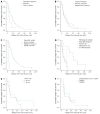Recurrent abdominal liposarcoma: analysis of 19 cases and prognostic factors
- PMID: 23840151
- PMCID: PMC3703193
- DOI: 10.3748/wjg.v19.i25.4045
Recurrent abdominal liposarcoma: analysis of 19 cases and prognostic factors
Abstract
Aim: To evaluate the clinical outcome of re-operation for recurrent abdominal liposarcoma following multidisciplinary team cooperation.
Methods: Nineteen consecutive patients who had recurrent abdominal liposarcoma underwent re-operation by the retroperitoneal sarcoma team at our institution from May 2009 to January 2012. Patient demographic and clinical data were reviewed retrospectively. Multidisciplinary team discussions were held prior to treatment, and re-operation was deemed the best treatment. The categories of the extent of resection were as follows: gross total resection (GTR), palliative resection and partial resection. Surgical techniques were divided into discrete lesion resection and combined contiguous multivisceral resection (CMR). Tumor size was determined as the largest diameter of the specimen. Patients were followed up at approximately 3-monthly intervals. For survival analysis, a univariate analysis was performed using the Kaplan-Meier method, and a multivariate analysis was performed using the Cox proportional hazards model.
Results: Nineteen patients with recurrent abdominal liposarcoma (RAL) underwent 32 re-operations at our institute. A total of 51 operations were reviewed with a total follow-up time ranging from 4 to 120 (47.4 ± 34.2) mo. The GTR rate in the CMR group was higher than that in the non-CMR group (P = 0.034). CMR was positively correlated with intra-operative bleeding (correlation coefficient = 0.514, P = 0.010). Six cases with severe postoperative complications were recorded. Patients with tumor sizes greater than 20 cm carried a significant risk of profuse intra-operative bleeding (P = 0.009). The ratio of a highly malignant subtype (dedifferentiated or pleomorphic) in recurrent cases was higher compared to primary cases (P = 0.027). Both single-factor survival using the Kaplan-Meier model and multivariate analysis using the Cox proportional hazards model showed that overall survival was correlated with resection extent and pathological subtype (P < 0.001 and P = 0.02), however, relapse-free interval (RFI) was only correlated with resection extent (P = 0.002).
Conclusion: Close follow-up should be conducted in patients with RAL. Early re-operation for relapse is preferred and gross resection most likely prolongs the RFI.
Keywords: Overall survival; Recurrent abdominal liposarcoma; Relapse-free interval.
Figures


Similar articles
-
Single-center experience with intra-abdominal liposarcoma: Optimal minimum duration for postoperative remnant tumor screening.Medicine (Baltimore). 2017 Aug;96(33):e7537. doi: 10.1097/MD.0000000000007537. Medicine (Baltimore). 2017. PMID: 28816941 Free PMC article.
-
[Results of surgical therapy of primary and recurrent retroperitoneal liposarcoma].Langenbecks Arch Chir Suppl Kongressbd. 1996;113:234-6. Langenbecks Arch Chir Suppl Kongressbd. 1996. PMID: 9101841 German.
-
Characteristics of primary and repeated recurrent retroperitoneal liposarcoma: outcomes after aggressive surgeries at a single institution.Jpn J Clin Oncol. 2020 Dec 16;50(12):1412-1418. doi: 10.1093/jjco/hyaa126. Jpn J Clin Oncol. 2020. PMID: 32699905
-
Optimal treatment strategy for paratesticular liposarcoma: retrospective analysis of 265 reported cases.Int J Clin Oncol. 2020 Dec;25(12):2099-2106. doi: 10.1007/s10147-020-01753-3. Epub 2020 Jul 26. Int J Clin Oncol. 2020. PMID: 32715355
-
Pleomorphic liposarcoma: An analysis of 6 case reports and literature review.Medicine (Baltimore). 2018 Feb;97(8):e9986. doi: 10.1097/MD.0000000000009986. Medicine (Baltimore). 2018. PMID: 29465602 Free PMC article. Review.
Cited by
-
Primary Myxoid Liposarcoma of the Greater Omentum in a Rhesus Macaque (Macaca mulatta).Comp Med. 2018 Aug 1;68(4):308-313. doi: 10.30802/AALAS-CM-18-000013. Epub 2018 Aug 2. Comp Med. 2018. PMID: 30071917 Free PMC article.
-
Survival outcomes of surgery for retroperitoneal sarcomas: A systematic review and meta-analysis.PLoS One. 2022 Jul 28;17(7):e0272044. doi: 10.1371/journal.pone.0272044. eCollection 2022. PLoS One. 2022. PMID: 35901187 Free PMC article.
-
A Multi-Modality Treatment of Retroperitoneal De-Differentiated Liposarcoma.Am J Case Rep. 2020 Mar 2;21:e919245. doi: 10.12659/AJCR.919245. Am J Case Rep. 2020. PMID: 32115569 Free PMC article.
References
-
- Goss G, Demetri G. Medical management of unresectable, recurrent low-grade retroperitoneal liposarcoma: integration of cytotoxic and non-cytotoxic therapies into multimodality care. Surg Oncol. 2000;9:53–59. - PubMed
-
- Erzen D, Sencar M, Novak J. Retroperitoneal sarcoma: 25 years of experience with aggressive surgical treatment at the Institute of Oncology, Ljubljana. J Surg Oncol. 2005;91:1–9. - PubMed
-
- Shibata D, Lewis JJ, Leung DH, Brennan MF. Is there a role for incomplete resection in the management of retroperitoneal liposarcomas? J Am Coll Surg. 2001;193:373–379. - PubMed
Publication types
MeSH terms
LinkOut - more resources
Full Text Sources
Other Literature Sources

